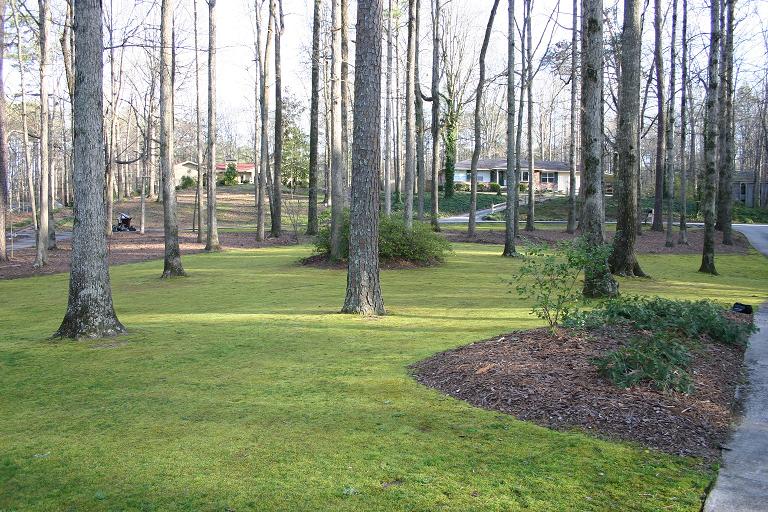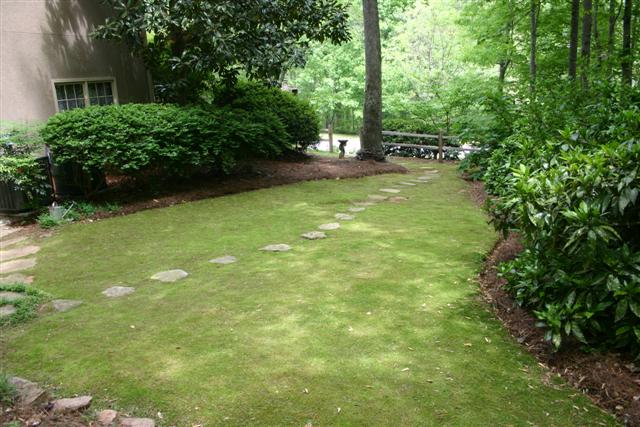Design Tip: December 10, 2009
Moss Lawns & Gardens

|

|
|
An Acre of Moss Lawn
|
A Path Through A Moss Groundcover
|
Using Moss as an alternative ground cover in areas too shady to support grass is a gardening
trend that is slowly catching on in popularity. Moss gardening has been used extensively
in Japan for centuries. Not only can moss be a suitable turf alternative, but it can
be used in rock gardens or near ponds. Some mosses will even grow in full sun.
Most moss lawns begin as a battle between turf-wanting gardeners and Mother Nature.
Grass is repeatedly planted in areas that won't support turf. The turf may look
good for a short amount of time, but in dense shade or poor soils, it begins to fail.
Often moss is already present and many people mistakenly blame the moss for the demise
of the grass.
Environmental Conditions For Moss
The environmental conditions that favor moss are almost completely opposite of those
needed for turf grasses. Moss grows best in:
*Partial to full shade
*Compacted and poorly draining soil
*Moist areas (although this is not required)
*Soil that is slightly to moderately acidic
I am not a Bryologist, so for me to positively identify a moss species can be very tricky.
There are hundreds of species of moss that are native to the Eastern United States. All
moss lawns will have multiple species of moss. My moss lawn has at least 5 different species
giving it a variety of colors and textures. The mosses that make the best ground covers
are those that are practically flat. Those mosses that are taller (between 1/4 to 1 inch)
will usually not withstand foot traffic and are best used as specimens tucked between
rocks or in areas where no one will walk.
Preparing an Area for a Moss Lawn
Remove the last remnants of turf grasses and weeds by spraying the entire area with a
general herbicide, such as Roundup. If moss is already present, dilute the Roundup to
half strength and do a test patch on a small area of the moss to test for herbicide
sensitivity. Most mosses will survive being treated with Roundup, but they may
temporarily turn a lighter green or pale yellow.
Remove all debris from the area: dead weeds and grass, mulch, etc. You should have
bare soil visible. Do not amend the soil. Moss prefers the nasty, compacted
red clay.
If moss is already beginning to grow, simply mist the area every few days. You only need
several seconds of water - just enough to dampen the surface. If you want, you can mix a
cup of buttermilk into a gallon of water and use that to fertilize the area.
It's possible to transplant moss into the area. Moss has no roots, so it can simply be
scraped off the ground. I use a trowel for this purpose in order to get the largest intact
pieces possible. Do not collect moss from private property without permission or from
public land or parks at all. Tamp the new moss into place and moisten it frequently.
Moss can be transplanted at any time of year, but it grows fastest in damp cool weather,
especially from the fall through early spring.
You can "seed" moss into areas in two ways:
*Take a walnut-sized clump of moss and mix it with buttermilk and water in the blender.
Make sure that the clump is completely broken apart which may require running the blender
on puree for some time. Pour the slurry on the desired areas. Moisten frequently.
*Take dried pieces of moss and crush them over the desired area. Moisten frequently.
Minimize the foot traffic in these areas until the moss is fairly established.
Maintaining a Moss Lawn
The most important thing to do for moss is to keep it open to the air by removing fallen leaves,
pine straw or mulch. If it remains covered for too long, it will go dormant and eventually die.
Weed control can be maintained in several ways: herbicides, pre-emergents and hand pulling. If you
have a large moss area and/or limited time, I suggest going the chemical route to maintain a weed-free
moss lawn. You can apply broadleaf weed killers (such as Weed-B-Gone) to the moss lawn without
causing much, if any damage. Use Roundup at half strength after testing it on a small area.
I do apply pre-emergent granular weed preventers at least twice a year: early March and mid September.
I've never noticed any problems using pre-emergents on moss.
Never, ever use fertilizers, products with iron or zinc, or lime on moss gardens
as it can damage the moss. Use the
mixture of buttermilk and water mentioned above to fertilize your moss lawn, but it will rarely
need it.
I do walk on my moss lawn and push a wheelbarrow over it to access other areas. However, moss
cannot take the heavy foot traffic of a play area or repeated trampling by dogs.
Moss remains evergreen throughout the year, but turns a gray-green color in hot, dry weather.
It's surprisingly drought tolerant and in the worst of conditions, will simply go dormant.
It will green up IMMEDIATELY upon getting wet.
Sources and References
There are a few limited places to buy living moss. One such place is
Moss Acres, but it's not cheap.
There are also several books on the subject:
Moss Gardening... by George Schenk
Gathering Moss... by Robin Wall Kimmerer
Unless noted otherwise, Images & Drawings Copyrighted © 2009 by Theresa Schrum - All rights reserved



